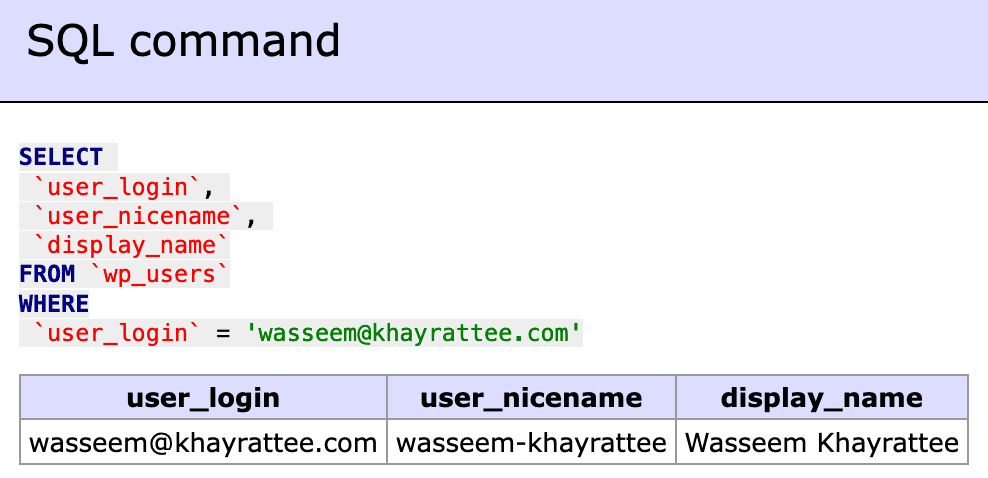Quick Difference (TL;DR)
- user_login is the username that a user uses to log in to WordPress - the internal username. It can contain any characters, including spaces, special characters and numbers. It is meant to be used internally.
- user_nicename is the more user-friendly version of the user_login - a user-friendly slug. It can only contain letters, numbers and underscores. It is meant to serve as the slug for the author’s profile page permalink structure.
user_nicename is basically the user_login filtered to conform to URL standards.
By default: user_nicename = sanitize_title(user_login)
Table of contents
Open Table of contents
Introduction
In WordPress, user identification is crucial for managing and organizing user accounts effectively. Two commonly used user identification attributes are user_login and user_nicename.
Although they might seem similar (at first glance), they are significant different from each other with different purpose(s) respectively.
If you are a WordPress dev, it’s even more important you get an understanding of their differences.
What is user_login?
- user_login is used for the authentication process
- is also technically known as the username
- serves as the primary identifier for user accounts within the WordPress system
Format requirements for user_login
- The ‘user_login’ string can include uppercase and lowercase letters, numbers, hyphens, underscores, periods and the at symbol (@). (Reference drawn directly from the WordPress
sanitize_userfunction). - user_login must be unique
When a user creates an account on a WordPress site, they are required to choose a unique user_login - typically in the form of an alphanumeric string referred as the username or login name. User_login is used for authentication purposes and is not meant to be displayed publicly.
Editability: How to change user_login?
- user_login cannot be changed through the WordPress admin interface once the user account is created. If you want to change this, you’ll need to use either a plugin, custom code (programmatically) or manipulate the database directly using something like phpMyAdmin or adminer.
- If you are an advanced WordPress user or a WordPress developer, you can leverage WP-CLI as well for this purpose.
- Generally not recommended to change, unless you really know what you are doing

Visibility: Security aspect of user_login
- user_login should not be publicly displayed to ensure security and prevent unauthorized access attempts.
What is user_nicename?
- Technically: user_nicename is the sanitized and URL-friendly version of ‘user_login’
- It is used for creating the user-specific URLs - the slug for the author profile page permalink URL.
For instance, if your ‘user_nicename’ is ‘wasseem’, your author archive URL will be ‘https://wk.pe/author/wasseem’.
- By default, WordPress will auto-generate the user_nicename based on the user’s username aka the
user_login
If your
user_loginis wasseem-khayrattee, theuser_nicenamewill bewasseem-khayratteeBut if your ‘user_login’ is
[email protected], theuser_nicenamewill be wasseemkhayrattee-comAs you have observed, essentially: user_nicename = sanitize_title(user_login)

Format requirements for user_nicename
- The ‘user_nicename’ string can contain only lowercase letters and hyphens. Any uppercase letters, spaces and other special characters in the ‘user_login’ are automatically converted into lowercase letters and hyphens in the ‘user_nicename’.
- user_nicename must be unique
Editability: How to change user_nicename?
- The ‘user_nicename’ cannot be changed directly from the WordPress admin interface by default.
- But this can be done programmatically or using a plugin whereby you would be able to change it by simply changing the “display name” from the user admin profile interface.
In this case, WordPress will now do:
user_nicename = sanitize_title(display_name)

And if you view the above using a database tool like Adminer:

Visibility: Security aspect of user_nicename
- user_nicename is often displayed publicly as part of the user’s profile or in author attribution for posts and comments..etc.
Best Practices:
Choosing user_login
- Avoid using easily guessable or common usernames to prevent brute-force attacks
- Regularly audit user accounts to identify and address any potential security vulnerabilities
- Use two-factor authentication to further secure your account
Choosing user_nicename
- Avoid excessive special characters, spaces or URL-unfriendly characters in the user_nicename to maintain compatibility with permalinks
- It’s often simpler to customize the user_nicename to reflect a user’s preferred display name
A word of caution
Whenener you do a change in either the user_login or user_nicename, do make sure to implement proper redirections or update any relevant internal links to prevent broken links and undesired effects.
Whenever you have a doubt, get the help of a professional WordPress developer.
Summary
While both ‘user_login’ and ‘user_nicename’ are crucial to user management and user identification in WordPress, they serve different purposes.
‘user_login’ is used for the authentication process and cannot be changed through the WordPress admin interface, while ‘user_nicename’ is used for author archive URLs and can be modified as needed.
Understanding the difference between these two terms can help you make better programmatic decisions when developing a feature or doing some custom coding within WordPress.
